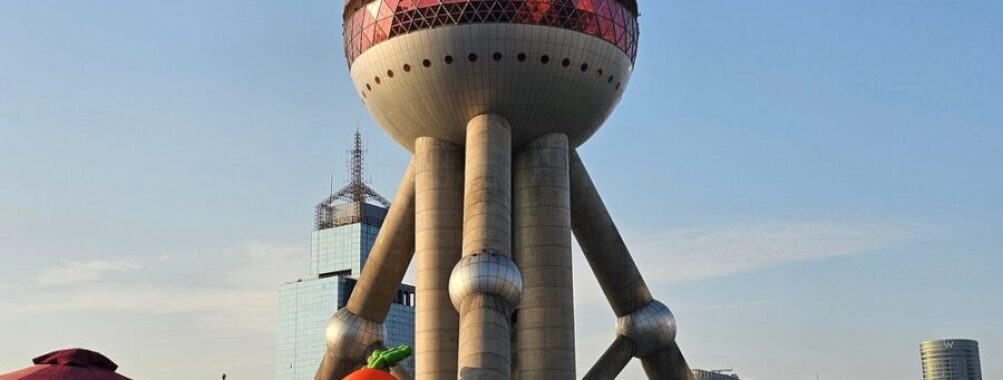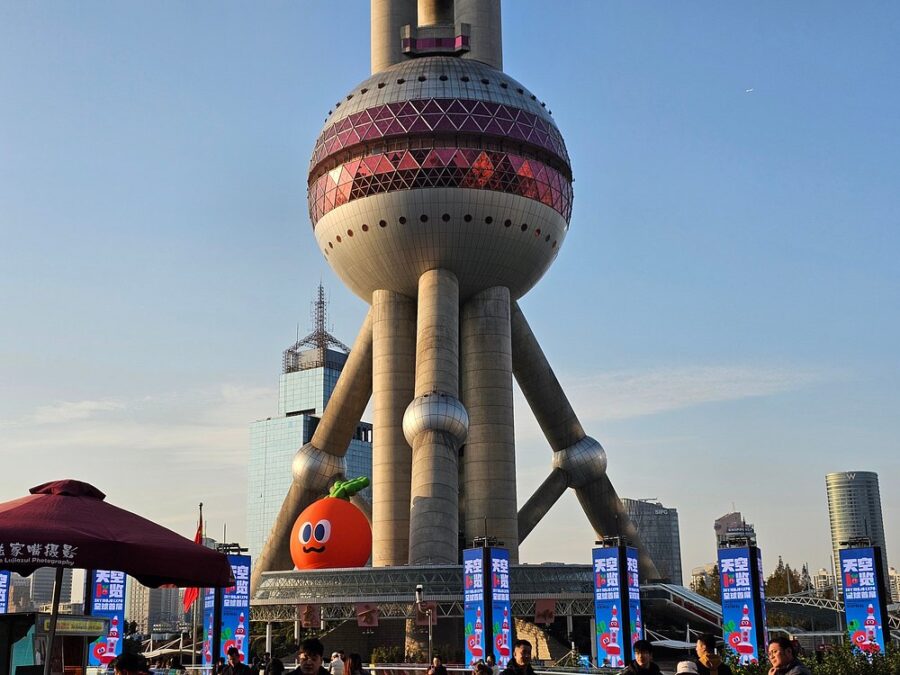
Oriental Pearl TV Tower
Table of Contents
History and Significance

If you’re heading to Shanghai, the Oriental Pearl TV Tower instantly becomes a must-see landmark, standing boldly in the skyline as both a symbol of the city’s rapid modernization and a bridge between traditional culture and futuristic ambition. This iconic tower, completed in 1994 after several years of challenging construction, marked a defining moment in Shanghai’s architectural and urban narrative. When it was built, it was the tallest structure in China and Asia, a daring statement of economic progress at the dawn of China’s opening to the world.
Located in the heart of Pudong’s bustling Lujiazui financial district, overlooking the historic Bund, the tower’s design embodies more than just utility for broadcasting—it’s infused with rich cultural symbolism. Inspired by a Tang dynasty poem about “pearls of varying sizes falling on a jade plate,” its eleven spheres are artfully arranged to evoke a composite jewel, shining over Shanghai’s fast-changing skyline.
The Oriental Pearl Tower is also historically significant because it coincided with the remarkable transformation of Pudong from farmland and docks to the glittering financial hub it is today. The tower, towering at 468 meters including its antenna, is not just a feat of engineering but a cultural beacon reflecting China’s economic rebirth and ambition in the 1990s.
Main Attractions and Activities
Once you arrive at the Oriental Pearl Tower, a host of attractions await, layering old-world charm with high-tech spectacle:
-
Observation Decks: The tower features three main observation platforms, with the most popular being at 263 meters. It offers sweeping 360-degree panoramic views of Shanghai’s skyline, the Huangpu River, and the sprawling cityscape stretching beyond. You’ll get glimpses of landmarks like the Jin Mao Tower, Shanghai Tower, and the historic buildings along the Bund.
-
Glass-Floored Deck: For the bold, there’s a thrilling glass floor section on the high deck that lets you gaze directly down to the city streets hundreds of meters below—heart-stopping and mesmerizing.
-
Space Capsule (Skywalk) Observation Deck: At 351 meters, this capsule houses an observation lounge, an interactive exhibition, and a coffee bar, giving you a futuristic vibe as you look down on the city lights.
-
Revolving Restaurant: Dining at the restaurant 267 meters up is a unique experience—the entire floor revolves slowly, providing diners 360-degree views while enjoying gourmet Chinese and international cuisine.
-
Shanghai History Museum: Located at the base of the tower, this museum offers fascinating exhibits tracing Shanghai’s transformation from a modest fishing village to a global metropolis. Interactive displays, historical artifacts, and recreated street scenes tell the city’s rich story.
-
Gift Shops and Art Exhibits: The tower’s podium and lobby feature shops selling souvenirs and rotating exhibits of contemporary Chinese art, blending culture with commerce.
-
Large LED Light Shows: Every evening, the tower transforms into a canvas of vibrant LED colors and patterns, synchronizing with music and illuminating the Pudong skyline spectacularly.
Visitor Experience
Stepping into the Oriental Pearl Tower is an invitation to transcend both space and time. The whole journey—from queuing in the futuristic lobby to riding ultra-fast elevators—is an experience packed with anticipation.
I remember my first visit on a chilly winter night; ascending through the glass-walled elevator, watching city lights shift and sparkle beneath me, I felt a heady mix of excitement and awe—Shanghai sprawled in every direction like a living constellation.
At the observation decks, the atmosphere buzzes with visitors from all over the world, some capturing selfies with the city behind, others silently soaking up the view. The glass floor segments add an adrenaline rush that’s not for the faint-hearted.
Dining in the revolving restaurant was dreamy: as our table inched around the skyline, I glimpsed the river shimmering, the city’s skyscrapers lit, and felt utterly suspended between modernity and the infinite.
The museum below contrasts beautifully with this futuristic vibe, offering a rich historical context that grounds your visit in local heritage.
Tips for Visitors
You’ll want to make your trip smooth and memorable:
-
Buy tickets online in advance to avoid long lines, especially on weekends or holidays.
-
Visit in the late afternoon to enjoy daylight city views transitioning into a magical nighttime light show.
-
Reserve a table at the revolving restaurant ahead of time if you want the full dining experience.
-
Bring a light jacket, as it can get chilly on higher observation decks.
-
Use the public transport system: The nearest metro station is Lujiazui, just a short walk from the tower.
-
Arrive early to explore the Shanghai History Museum at a relaxed pace before heading up.
-
Carry a good camera or smartphone since almost every angle offers a stunning photo opportunity.
-
Beware of height-sensitive visitors; some platforms may induce dizziness.
-
Check event schedules—special exhibitions and light shows add extra sparkle to visits.
Accessibility and Facilities
The Oriental Pearl Tower is well-equipped for diverse visitor needs:
-
High-speed elevators ensure quick and comfortable ascents for all.
-
Wheelchair access is available throughout public areas, including observation decks.
-
Restrooms, cafes, and gift shops are conveniently located.
-
Signage is clear in both Mandarin and English, facilitating easy navigation.
-
Trained staff assist, including guides for the hearing or visually impaired.
-
Baby changing facilities and stroller rentals are available.
-
The location is well-served by metro, buses, and taxis. Parking near Lujiazui is limited and can be costly.
Unique Features
The tower’s unique appeal lies in:
-
Its architectural originality, by 11 non-uniform spheres creating a futuristic yet poetic silhouette.
-
The revolving restaurant is at a dizzying height, rare in Asian towers.
-
The combination of entertainment, dining, museum, and observation platform is integrated seamlessly.
-
It’s role as a nighttime beacon with stunning LED displays illuminating the skyline.
-
The Space Capsule deck offers ultra-modern comfort with a futuristic design.
-
The rich historical exhibitions on site make it both an entertainment and educational destination.
Overall Impressions
Honestly, the Oriental Pearl Tower is not just a radio or TV mast; it’s Shanghai’s shining star, pulsating with energy, history, and modernity. From the moment you approach the gleaming spheres towering over the Huangpu River to the breathtaking vistas from the observation decks, the experience impresses again and again.
It’s a perfect fusion of technology and culture, offering something for everyone—photographers, history buffs, food lovers, or casual tourists wanting to grasp Shanghai’s scale and soul.
The interplay of light and glass, height and history, makes each visit feel unique. Whether watching the city awake at dawn, glow at dusk, or dazzle at night, you walk away with a sense of awe and a newfound appreciation for China’s rapid evolution.
Pros and Cons
| Pros | Cons |
|---|---|
| Iconic architectural design symbolizing Shanghai | Lines can be long during weekends and holidays |
| Panoramic views from multiple observation decks | Tickets can be pricey, dining especially so |
| Unique revolving restaurant offering dining with a view | It can be very crowded at peak times |
| Excellent accessibility and family-friendly facilities | Higher floors might be challenging for those afraid of heights |
| Vibrant LED light shows create a spectacular nightscape | Museums can be overlooked compared to observation decks |
| Integration of cultural exhibitions, shopping, and entertainment | Limited parking in the busy Pudong district |
Location
Places to Stay Near Oriental Pearl TV Tower
Find and Book a Tour
Explore More Travel Guides
No reviews found! Be the first to review!